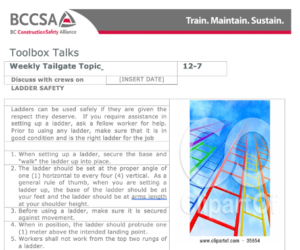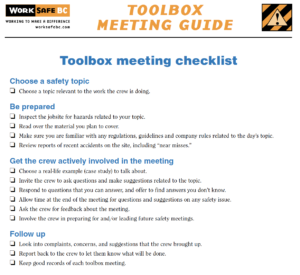Effective Communication Practices
Toolbox Meetings
Toolbox Meetings
Meetings are usually short in duration and are typically recorded through documentation. This documentation is usually referred to as a ‘Field Level Risk Assessment’ (FLRA) or a Site-Specific Safety Requirement (SSSR).
Toolbox meetings are an effective method for reviewing and refreshing common safety concerns as well as raising the safety awareness within a crew. They are designed as an information exchange where everyone participating can contribute their knowledge and experience.
Toolbox meetings are also designed to facilitate health and safety concerns on the job site and assist in promoting a company’s safety culture.
WorkSafe BC – Ladder Safety
An example of a document used for the purpose of a toolbox meeting may look like the following;

WorkSafeBC has an example page of toolbox items that might be included in a typical meeting. The following is an example of what topics may be included in a toolbox meeting;

More Than Stats…
The most recent statistics from the Association of Workers’ Compensation Boards of Canada (AWCBC) tell us that in 2017, 951 workplace fatalities were recorded in Canada, an increase of 46 from the previous year. Among these deaths were 23 young workers aged 15-24.
Add to these fatalities the 251,508 accepted claims (an increase from 241,508 the previous year) for lost time due to a work-related injury or disease, including 31,441 from workers aged 15-24, and the fact that these statistics only include what is reported and accepted by the compensation boards, there is no doubt that the total number of workers impacted is even greater.
And it’s not just these numbers on which we need to reflect. With each worker tragedy, there are loved ones, family members, friends, and co-workers who are directly affected, left behind, and deeply impacted – their lives also forever changed.[1]
Key Takeaways
Resources:
BC Construction Safety Alliance:
https://www.bccsa.ca/Toolbox-Talks-.html?
Canadian Centre for Occupational Health and Safety
Canadian Centre for Occupational Health and Safety – Day of Mourning
https://www.ccohs.ca/events/mourning/
WorkSafeBC Toolbox Meeting Checklist:
[1] Canadian Centre for Occupational Health and Safety – https://www.ccohs.ca/events/mourning/

